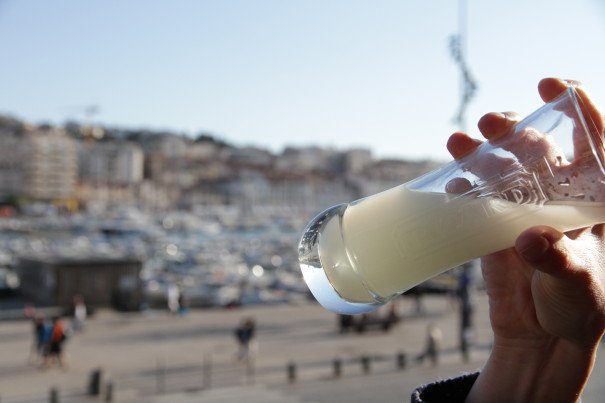
In Marseille, Sunshine in a Glass

In Marseille, Sunshine in a Glass
Over Easter break we visited Les Goudes, a small fishing village on the outskirts of Marseille. It’s one of those soulful places, consisting of not much more than a scattering of weatherworn fishermen’s cottages, and an equally weatherworn population who, when it comes to visitors, are either perpetually amused by or in denial of their existence.
On Sunday morning, in desperate need of coffee to remedy the decision to end the previous evening with a shot of local moonshine, I insisted that we walk down the blink-and-you’d-miss-it main street on the off-chance that somewhere would be open. I was pleasantly surprised to discover that one of the two bars was packed – the locals were spilling out on the street with their cups of joe. As I came closer though, I realized that – at 10.30am on Easter Sunday, well before the sun was over the yardarm – the vast majority of those cups were actually glasses, filled not with coffee but with an unmistakable murky, yellow substance: pastis.
Sure, pastis is just one stop on the licorice-scented pub crawl that stretches around the Mediterranean. There’s ouzo in Greece, sambuca in Italy, raki in Turkey, and arak in Lebanon. Cross over to Africa and you’ll find people swilling anisette in Algeria. Some say this shared spirit of spirits can be attributed to flavor and function. Herbal aniseed makes an appetite-whetting gateway to the strong, sharp base flavors of the region’s meals – think olives, garlic, spices, and citrus. At the same time, strong liquor is also a digestive aid and presumed health tonic, perfect for ending (and prolonging) the multi-course feasts that play a central role in the social life of Mediterranean countries. But pastis can only ever be ‘comme à Marseille’.
When drinks achieve iconic status in a specific location, it’s sometimes difficult to know whether imbibing them will irrevocably render you an out-of-towner or one of the crowd. It’s about knowing the codes – the language, the rituals. Luckily with pastis, it’s pretty easy to fudge. You can drink it anywhere, at any time; the most important thing is to not, under any circumstance, allow people to think you are Parisian.
The bitter rivalry between Marseille and the capital of the country it begrudgingly shares a nationality with goes well beyond the football pitch. While the Marseillaise write off Parisians as uptight snobs, Parisians harbor a kind of morbid curiosity for the mean streets of the port city. Its grimy neighborhoods, with the blaring Arabic music and impossible number of pizzerias, feel closer to Italy or North Africa than the Eiffel Tower. The southern swag is basically a middle finger to the well-groomed aesthetic of la capitale – here, tracksuits, not scarves, are de rigeur.
Despite that, Parisians do share the unconditional love for the yellow peril – for one, simple reason. Decades of promotional campaigns have taught Parisians that Marseille equals pastis, and pastis means summer. There’s no better antidote to the dying throes of a grey Parisian winter than sunshine in a glass.
That Pavlovian link is no accident. The popularity of pastis can be partly explained by its role in skirting pesky prohibition-style laws, which spelt the end of the boozy Belle Époque tipple absinthe. Helped along by the enterprising M. Ricard, the weaker, more morally digestible pastis capitalized on the existing Provençal tradition, and sealed its fate when the French were awarded their first paid holidays in 1936. Anticipating the south-bound tourism flux, pastis producers ran with the now-iconic advertising imagery that would create that enduring summertime syllogism.
As a Parisian with a deep affinity for Marseille’s gritty underbelly, I guess that’s called having your pastis and drinking it too. Fortunately, my Australian passport enables me to neatly sidestep curly questions about my current postal code. Now, all that stands between me and the locals is adding pastis to my breakfast menu.